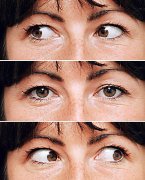Liaison psychiatrist Dr P told me to close my eyes and think of a relaxing place. “Imagine the smells, the sounds, the sensations like sun and wind and soft cloth.” I was bobbing away in a rowing boat upon a calm sea when he pressed the button. The two 2p-sized buzzers in each of my hands began to vibrate alternately, slooowly, and the smell of the salty breeze became more vivid.
He was letting me experience EMDR – Eye Movement Desensitisation and Reprocessing. In the original EMDR technique, instead of holding alternately vibrating buzzers in each hand, the patient was told to watch the doctor’s hand as it went from side to side without moving the head – that’s the ‘Eye Movement’ part of EMDR. Nowadays, any sort of ‘bilateral stimulation’ is used – that is, alternately using the left and right sides of the brain, for example, by tapping one’s knees alternately, or holding the buzzy things as I did.
And yes, I did write ‘doctor’, and I did write ‘patient’ – not ‘therapist’ and ‘client’. It’s a medical treatment used to ease traumatic memories that have lead to mental health complications, such as post-traumatic stress disorder (PTSD). I simply did the relaxation cool-down part, whereas a proper EMDR session would require the patient to think of a traumatic memory, something that causes great anxiety whenever it comes to mind. Over several repetitions of bilateral stimulation, the patient can become quite desensitised to the traumatic memory. Sounds quacky? I know. And that’s what the scientific community thought when Francine Shapiro first put it out there.
This is a good story. She discovered it by accident, Fleming-style. She has some distressing thoughts of her own, and whilst on a walk in the park she realised that she could recall them “without charge”, which was weird seeing as she hadn’t deliberately done anything to deal with them. Conscious that something else may be going, she noticed that whenever a disturbing thought pushed its way to the surface of her mind, her eyes moved rapidly and the thoughts muted. For the lols, she asked others to try it and found it was not a unique experience. And thus the idea took seed.
Shapiro conducted some studies to test her developed therapy. It all got ‘pooh-poohed’. More and more studies came about, and over time, it matured into an evidence-based medical treatment. Still, this mind-boggling treatment seems all the more absurd because we don’t really know how it works. Not really. There are some ideas around.
In a right-handed person, traumatic memories are ‘stored’ in the right amygdala, an almond-shaped area of the brain associated with powerful instinctive emotions such as fear. There are many theories for a more precise mechanism, but generally it is thought that the EMDR process reprocesses the memory to the left frontal lobe, the ‘normal’ storage area of memories. In this area of the brain, memories tend to be more logically organised and more distant when recalled. For example, remember what you did on the first day of this year. If you’re like me, it may take a while to recall where you were, never mind what you actually did. And when you do, it’ll seem far away; unless something big happened that day, you will remember it without strong emotional attachment. So EMDR turns traumatic memories into distant ones like New Year’s Day. And this is supported by before-and-after brain scans of EMDR patients.
But I’m fortunate to have no traumatic memories as of yet, unless you count the sight of my brother’s face in the early morning. Dr P thought it more worthwhile for me to experience the relaxation technique rather than desensitising that disturbing memory. That’s how I came to be serenely bobbing in a rowing boat on a gentle sea during my work shadowing experience in liaison psychiatry.
